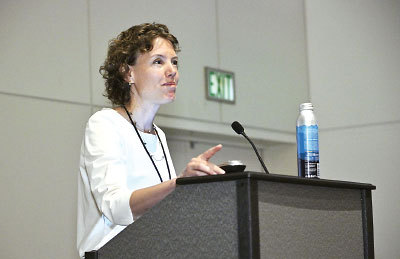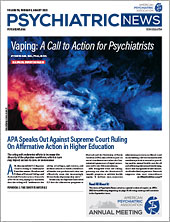Women are prescribed more medications than men, and in recent years the percentage of women taking psychiatric medications has only increased. Psychiatrists who treat women of reproductive age should assume their patients are going to get pregnant and keep that in mind when making treatment decisions, said Veerle Bergink, M.D., Ph.D., this year’s recipient of the Alexandra Symonds Award.
“Our primary interest is to keep the mother healthy,” Bergink said during her award lecture at APA’s 2023 Annual Meeting. “If she is not well, she may try to self-medicate, she will not exercise, she will not eat well, and she will be stressed, and all these things have been well documented to have adverse effects on children later in life.”
Bergink is the director of the Women’s Mental Health Program at the Icahn School of Medicine at Mount Sinai and a professor in the departments of Psychiatry and Obstetrics, Gynecology, and Reproductive Science. The
Alexandra Symonds Award was established in 1997 to honor a woman psychiatrist who has made significant contributions to promoting women’s health and the advancement of women.
Psychiatrists prescribing medications to women of reproductive age should avoid polypharmacy if possible, she said. She also recommended using older medications that have more research behind them and avoiding newer medications about which less is known regarding the long-term effects on mothers and children. Additionally, some medications are well known to be dangerous during pregnancy, such as valproic acid and carbamazepine, and should be avoided in women of reproductive age, Bergink said.
She outlined
some of the research on numerous treatments for women with mental illness who are pregnant or postpartum. “It’s important to remember that every treatment that works at other times for depression and anxiety also works during the pregnancy and postpartum period,” she said.
Some patients who are on antidepressants when they become pregnant may be able to stop taking their medications because their illnesses have improved over the natural course of the disease, she said. “But of course, we don’t know which women will relapse,” she said, which is why the decision to stop or continue medication must be made between the patient and her physician on an individual basis. It has been well proven that mental health problems of mothers are linked to adverse outcomes in their children.
She also spoke about postpartum psychosis and the clinical differences between patients who experience psychosis onset for the first time after pregnancy and those who have a recurrent psychotic or manic episode following pregnancy. She argued that postpartum psychosis, which she said is a bipolar spectrum disorder, should have a distinct diagnostic code in DSM. Postpartum psychosis has a specific onset, phenotype, phenomenology, risk profile, and prognosis, she said, which leads it to have distinct prevention and treatment options.
She outlined a 2015 study that she and her colleagues conducted that investigated postpartum psychosis treatments and was published in The American Journal of Psychiatry. They evaluated 64 patients who experienced psychosis or mania only in the postpartum period. The patients were treated following an algorithm that included sequential treatment with benzodiazepines, antipsychotics, lithium, and electroconvulsive therapy (ECT). Ninety-eight percent of the patients achieved complete remission within the first three steps (treatment with benzodiazepines, antipsychotics, and/or lithium), and nearly 80% had sustained remission at nine months postpartum. Bergink and her colleagues recommended maintenance treatment using lithium during the first year of postpartum, then gradually tapering for those who have achieved full remission.
There is an urgent need for greater research on postpartum psychosis, she said, especially due to its tragic outcomes, the most extreme of which are suicide or infanticide, though she noted that infanticide is extremely rare. Some patients with first-onset postpartum psychosis with no prior history of psychosis may go on to develop bipolar disorder, while others may experience isolated episodes of psychosis only within the postpartum period.
“There must be something in the biology of the transition from pregnancy to postpartum that is triggering bipolar episodes,” Bergink said. ■


